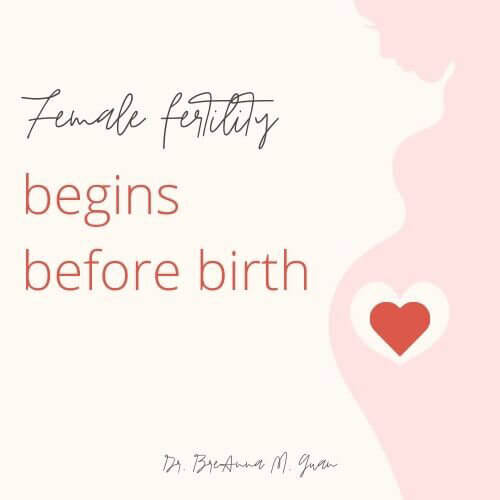
What is AMH?
Anti-Mullerian Hormone (AMH) is made in the reproductive tissues of both men and women but plays a big role in women’s reproductive health. AMH inhibits follicular stimulating hormone (FSH), so growing follicles are decreased. This is important because, without AMH, follicles would be recruited faster and would lead to early exhaustion of the follicle pool! AMH levels increase at birth and then steadily decline from age 25 until menopause1.
How does AMH impact fertility?
AMH levels can be assessed to determine the ovarian reserve in women. Follicles are not egg cells but they are vital for egg maturation. While AMH can’t measure the quality of an egg within a follicle, it does reflect an increased chance to get pregnant. Higher AMH levels will reflect more follicles and eggs available for pregnancy. As the follicle pool declines so do AMH levels, so this can be a useful test when trying to get pregnant. After age 30, women with normal AMH levels are more likely to get pregnant.
Healthy Levels of AMH by Age
Age- AMH level (ng/ml)
25- 5.4
30- 3.5
35- 2.3
40- 1.3
>43- 0.7
What does it mean if AMH levels are high?
AMH blood levels above 4.0 ng/ml has been linked to decreased fertility as seen in women with PCOS. While the reason AMH is high in PCOS is still unknown, it is thought that since high levels of AMH are seen with high levels of androgens, androgens could play a role on AMH expression2,3. Levels may be improved from a healthy diet and weight loss. Not only will AMH levels improve but so will blood sugar and insulin levels, all vital for a healthy reproduction system.
What does it mean if AMH levels are low?
AMH blood levels below 1.0 ng/ml could indicate a declining ovarian reserve which would translate to a harder time getting pregnant. Declining AMH levels are a part of a healthy aging process but there are ways to improve hormone levels and increase the likelihood of getting pregnant. DHEA is a steroid hormone that may improve low levels of AMH with accelerated disappearance of ovarian follicles. DHEA can be found over-the-counter in a supplement form but you can support DHEA synthesis naturally by exercising and reducing stress. Stress kills DHEA production in what is known as the “cortisol steal”. If your body is under stress it will prioritize making cortisol over reproductive hormones like DHEA, so take some time each day to rest!
Can the numbers be improved? Do they fluctuate?
AMH levels do not fluctuate significantly throughout a woman’s menstrual cycle4. Levels gradually increase from birth until around age 25 and then gradually decline until menopause. Smoking and long-term use of oral contraceptives can decrease AMH levels, so discontinuing these can help improve hormone levels. Vitamin D helps regulate AMH levels so eating wild-caught salmon and getting 15 minutes of direct sunlight a day can also improve vitamin D and AMH levels.
Takeaways for supporting fertility naturally?
All hormones depend on a healthy diet in order to function properly! Losing excess weight can improve androgen and AMH levels, thereby improving pregnancy outcomes. For women with low levels of AMH, supplementing with 75 mg of DHEA can improve the ovarian reserve, increase pregnancy chances and lower miscarriage rates5. Vitamin D also appears to be an important regulator of AMH6. Getting 15 minutes of direct sunlight exposure when it’s available and supplementing with 1,000 IU’s of Vitamin D in winter months can improve levels of AMH.
Sources
1. Shebl, O., Ebner, T., Sir, A., Schreier-Lechner, E., Mayer, R., Tews, G., & Sommergruber, M. Age-related distribution of basal serum AMH level in women of reproductive age and a presumably healthy cohort. American Society for Reproductive Medicine 95, 2 (2011), pages 832-834. DOI: https://doi.org/10.1016/j.fertnstert.2010.09.012
2. Grynnerup AG, Lindhard A, Sørensen S. The role of anti-Mullerian hormone in female fertility and infertility – an overview. Acta Obstet Gynecol Scand 2012;91:1252–1260.
3. Dumont, A., Robin, G., Catteau-Jonard, S. et al. Role of Anti-Müllerian Hormone in pathophysiology, diagnosis and treatment of Polycystic Ovary Syndrome: a review. Reprod Biol Endocrinol 13, 137 (2015) doi:10.1186/s12958-015-0134-9
4. Wouter J. K. Hehenkamp, Caspar W. N. Looman, Axel P. N. Themmen, Frank H. de Jong, E. R. te Velde, Frank J. M. Broekmans, Anti-Müllerian Hormone Levels in the Spontaneous Menstrual Cycle Do Not Show Substantial Fluctuation, The Journal of Clinical Endocrinology & Metabolism, Volume 91, Issue 10, 1 October 2006, Pages 4057–4063, https://doi.org/10.1210/jc.2006-0331
5. Gleicher and Barad: Dehydroepiandrosterone (DHEA) supplementation in diminished ovarian reserve (DOR). Reproductive Biology and Endocrinology 2011 9:67. doi:10.1186/1477-7827-9-67
6. Nicola A. Dennis, Lisa A. Houghton, Gregory T. Jones, Andre M. van Rij, Kirstie Morgan, Ian S. McLennan, The Level of Serum Anti-Müllerian Hormone Correlates with Vitamin D Status in Men and Women But Not in Boys, The Journal of Clinical Endocrinology & Metabolism, Volume 97, Issue 7, 1 July 2012, Pages 2450–2455, https://doi.org/10.1210/jc.2012-1213




